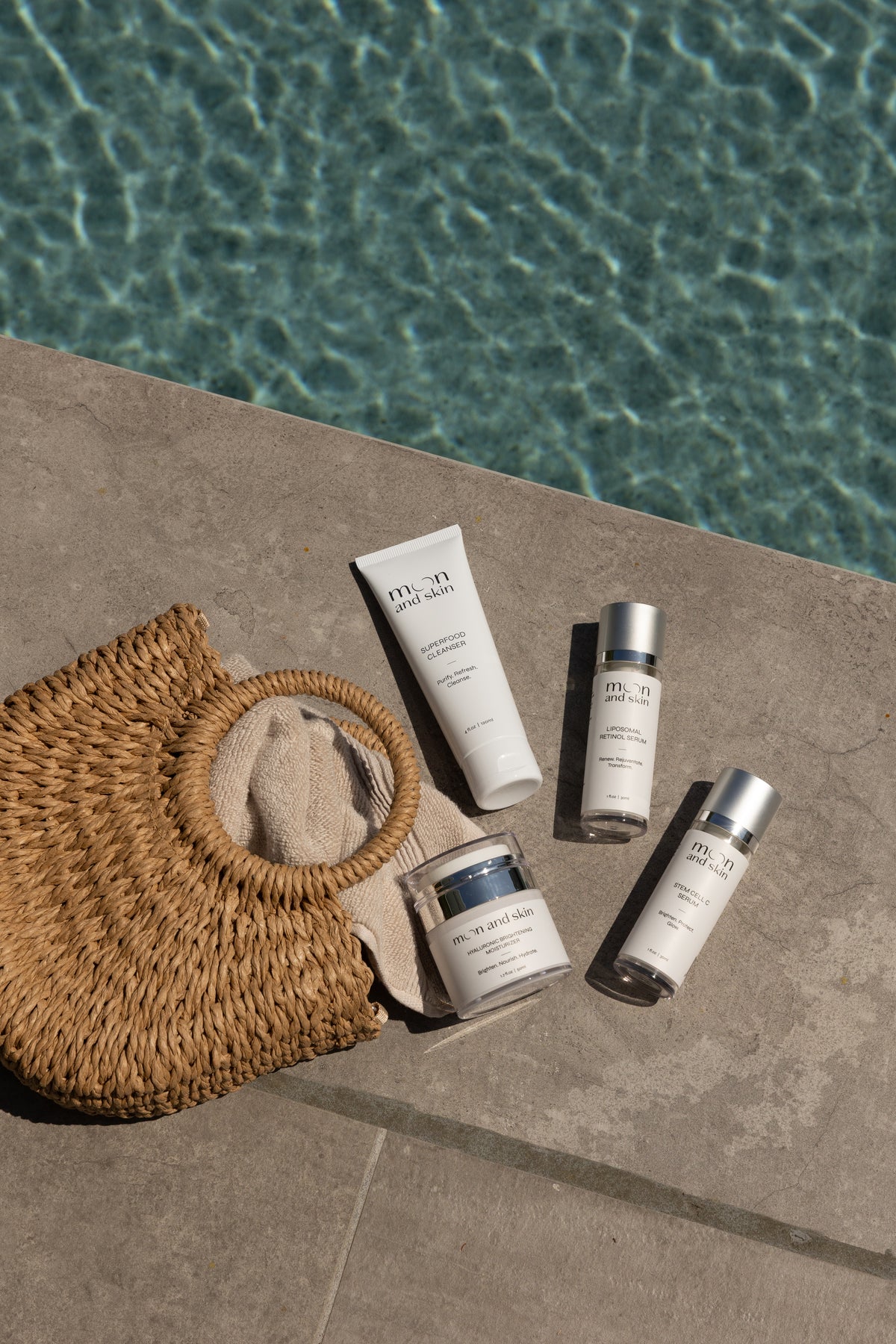Table of Contents
Introduction
Have you ever wondered why some people seem to have flawlessly glowing skin while others struggle with dryness, breakouts, or uneven tone? The answer often lies in their skincare routine. According to the American Academy of Dermatology, consistent and thoughtful skincare can significantly improve the health and appearance of your skin. In fact, a well-crafted skincare regimen isn’t just a luxury; it’s a necessity for maintaining the skin’s barrier and overall health.
At Moon and Skin, we understand that navigating the world of skincare can feel overwhelming. With countless products and conflicting advice, it’s easy to feel lost. That’s why we’re here to guide you through the essential components of an effective skincare routine, emphasizing our commitment to clean, thoughtful formulations that cater to every phase of life.
This blog post will explore the key elements of a skincare routine, from the fundamental products to the advanced treatments that can help you achieve your skincare goals. We’ll also highlight how our carefully curated products can support your journey toward healthy, radiant skin. Together, let’s break down what you truly need in a skincare routine.
Understanding Your Skin Type
Before diving into the products you need for an effective skincare routine, it’s crucial to understand your skin type. Knowing your skin type helps tailor your routine to address specific concerns and ensures you choose the right products. The primary skin types include:
- Normal Skin: Balanced, not too oily or dry.
- Dry Skin: Lacks moisture; may feel tight, rough, or flaky.
- Oily Skin: Excess sebum production, often leading to shine and enlarged pores.
- Combination Skin: A blend of oily and dry areas, often oily in the T-zone (forehead, nose, chin) and dry on the cheeks.
- Sensitive Skin: Prone to redness, irritation, or allergic reactions.
Take a moment to reflect: What does your skin feel like on a typical day? Identifying your skin type is the first step toward building a routine that works for you.
Key Takeaways:
- Knowing your skin type is essential for choosing the right products.
- Skin types can change with seasons, age, and environmental factors.
Step 1: Cleansing
Cleansing is the cornerstone of any skincare routine. It removes dirt, makeup, and impurities, preparing your skin for the products that follow. At Moon and Skin, we believe in the importance of gentle yet effective cleansing. Our Superfood Cleanser, formulated with HydroProtein Technology, ensures that your skin is nourished while effectively cleansing it.
Types of Cleansers:
- Gel Cleansers: Great for oily skin; they often contain ingredients like salicylic acid to help control excess oil.
- Cream Cleansers: Ideal for dry or sensitive skin; they provide hydration while cleansing.
- Micellar Water: A gentle option for removing makeup without stripping moisture.
How to Cleanse:
- Use lukewarm water to dampen your face.
- Apply a small amount of cleanser with your fingertips.
- Gently massage in circular motions for about 30 seconds.
- Rinse thoroughly and pat dry with a clean towel.
Key Takeaways:
- Cleansing prepares your skin for further treatment.
- Choosing the right cleanser is vital based on your skin type.
Step 2: Toning
Toners are often overlooked but can be a beneficial addition to your skincare routine. They help balance your skin’s pH and can provide extra hydration. Our Hyaluronic Brightening Moisturizer can double as a hydrating toner, ensuring your skin remains plump and nourished.
Benefits of Toning:
- Restores pH balance after cleansing.
- Prepares the skin to absorb serums and moisturizers effectively.
- Can provide additional hydration or oil control, depending on the formula.
Key Takeaways:
- Toners can enhance the effectiveness of your skincare routine.
- Look for toners with hydrating ingredients like hyaluronic acid or botanical extracts.
Step 3: Treatment Serums
Serums are concentrated formulations that target specific skin concerns, such as fine lines, dark spots, or dullness. At Moon and Skin, our Stem Cell C Serum is an excellent choice for brightening and hydrating the skin while providing antioxidant protection.
Types of Serums:
- Vitamin C Serums: Brighten the skin and protect against environmental damage.
- Retinol Serums: Promote cell turnover and improve the appearance of aging skin.
- Hyaluronic Acid Serums: Provide deep hydration and plumpness.
How to Apply:
- After toning, apply a few drops of serum to your fingertips.
- Gently press the serum into your skin, focusing on areas of concern.
- Allow a few moments for the serum to absorb before moving on to the next step.
Key Takeaways:
- Serums deliver targeted treatment for specific skin issues.
- Choose a serum that aligns with your skincare goals.
Step 4: Moisturizing
Moisturizers are essential for maintaining hydration and supporting the skin barrier. Regardless of your skin type, a moisturizer is crucial to lock in hydration and keep your skin balanced. Our Hyaluronic Brightening Moisturizer offers a lightweight, acne-safe option for those looking to hydrate without clogging pores.
Benefits of Moisturizing:
- Helps maintain the skin’s natural barrier.
- Prevents moisture loss, especially in dry or cold environments.
- Can improve skin texture and overall appearance.
How to Apply:
- Use a dime-sized amount of moisturizer.
- Gently massage it into your skin using upward motions.
- Don’t forget to apply it to your neck and décolletage.
Key Takeaways:
- Moisturizing is vital for all skin types, including oily skin.
- A good moisturizer can improve the overall look and feel of your skin.
Step 5: Sunscreen
Sunscreen is non-negotiable for any skincare routine, regardless of the season. Protecting your skin from harmful UV rays is crucial to prevent premature aging and skin cancer. Look for broad-spectrum SPF 30 or higher, and apply it every day as the last step in your morning routine.
Types of Sunscreens:
- Chemical Sunscreens: Absorb UV rays and often feel lighter on the skin.
- Physical (Mineral) Sunscreens: Contain zinc oxide or titanium dioxide and provide a physical barrier against UV rays.
How to Apply:
- Apply generously to all exposed skin, including the face, neck, and ears.
- Reapply every two hours, especially if you’re outdoors or sweating.
Key Takeaways:
- Daily sunscreen use is essential for skin health.
- Choose a formulation that works with your skin type and lifestyle.
Step 6: Exfoliation
Exfoliation is an important step that helps remove dead skin cells and promote cell turnover. However, it should not be done daily. Depending on your skin type, exfoliating 1-2 times a week can improve skin texture and brightness.
Types of Exfoliants:
- Physical Exfoliants: Scrubs with granules that physically slough off dead skin.
- Chemical Exfoliants: Products containing AHAs (like glycolic acid) or BHAs (like salicylic acid) that dissolve dead skin cells.
How to Exfoliate:
- Apply your chosen exfoliant to clean, dry skin.
- Follow the instructions on the product for timing (typically 5-10 minutes for masks).
- Rinse thoroughly and follow up with a moisturizer.
Key Takeaways:
- Exfoliation promotes brighter, smoother skin.
- Choose the type of exfoliant based on your skin sensitivity and concerns.
Step 7: Night Routine Considerations
Your nighttime skincare routine is just as important as your morning routine, focusing on repair and rejuvenation. This is the time when your skin can benefit most from treatments, as it is free from the stressors of the day.
Night Routine Steps:
- Cleanse: Remove makeup and impurities accumulated during the day.
- Tone: Rebalance and hydrate.
- Treat: Apply serums targeted for nighttime use, such as retinol for anti-aging or hydrating serums.
- Moisturize: Use a heavier moisturizer or night cream to support skin repair overnight.
Key Takeaways:
- Nighttime is when your skin can focus on repair and rejuvenation.
- Use products formulated for nighttime to maximize benefits.
Building a Full Routine
As we explore the essentials of a skincare routine, you may be wondering how to assemble these components into a cohesive regimen. At Moon and Skin, we offer a Bundle & Save option that allows you to easily access our core products, ensuring you have everything you need for a complete skincare routine without overwhelming choices.
Benefits of a Full Routine:
- Each product complements the others, ensuring maximum effectiveness.
- Streamlined routines reduce the chance of irritation and reactions.
- Cost savings when purchasing products together.
Key Takeaways:
- Building a full routine with complementary products enhances results.
- Bundling products can save you money and time.
Conclusion
Creating a skincare routine tailored to your skin’s unique needs can be a transformative journey. By understanding your skin type, selecting the right products, and following a structured routine, you can achieve healthier, more radiant skin. At Moon and Skin, we are committed to supporting you through every phase of this journey with our clean, thoughtful products.
We encourage you to explore our Best Sellers collection to find our most popular products that have helped countless individuals in their skincare journeys.
Remember, whether you're just starting out or looking to refine your existing routine, we’re here to help you understand what you truly need in a skincare routine. Let’s embark on this journey together!
FAQ
Q: How often should I change my skincare routine?
A: It’s best to assess your skin regularly, especially with seasonal changes or shifts in hormones. If you notice changes in your skin, consider adjusting your routine accordingly.
Q: Can I use multiple serums in my routine?
A: While it’s possible to layer serums, it’s important to avoid combining too many active ingredients that could irritate your skin. Focus on a couple of serums that target your main concerns.
Q: Is it necessary to use a toner?
A: While toners aren’t essential for everyone, they can help balance the skin’s pH and provide extra hydration. If you find a toner that works for your skin, it can be a beneficial addition.
Q: What if I have sensitive skin?
A: If you have sensitive skin, opt for products that are fragrance-free and formulated specifically for sensitive skin. Always conduct a patch test before trying new products.
Q: How do I know if a product is right for me?
A: Look for products that address your specific skin concerns and are suitable for your skin type. Reading reviews and understanding the ingredients can also guide your choices.
By understanding what you need in a skincare routine and integrating our thoughtfully crafted products, you can achieve the healthy skin you deserve. Explore our offerings and begin your journey today!







